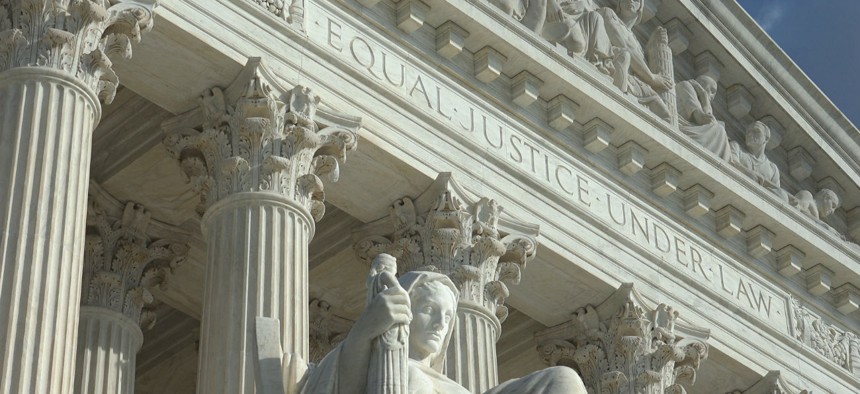Supreme Court Justices Skeptical of Current Standard for Federal Worker Age Discrimination Cases
Justices appeared to find the Trump administration’s egg-less baking analogy difficult to stomach, but also probed the hypothetical limits of installing a lesser standard to prove age was a factor in personnel actions at federal agencies.
Justices on the Supreme Court on Wednesday appeared ready to reject portions of the Trump administration’s arguments that federal courts should maintain the current strict standard for proving age discrimination in the federal workplace, although some expressed reservations about whether a lesser standard could amount to “regulation of speech.”
In the case Babb v. Wilkie, a Veterans Affairs Department pharmacist accused the VA of denying her advancement opportunities because of her age and gender, and in retaliation for previous Equal Employment Opportunity Commission complaints. Lower courts consistently ruled against her, because they applied a so-called “but for cause” standard that requires plaintiffs to prove discrimination was the deciding factor in a personnel action.
Noris Babb’s attorney, Roman Martinez, argued that the Age Discrimination in Employment Act sets differing standards for proving age discrimination. While in the private sector, the discrimination must be the proximate cause of the adverse action, language governing federal agencies states that personnel decisions must be made “free from any discrimination” based on age.
But Solicitor General Noel Francisco, representing the government, argued that only the final decision must be free of discrimination, and that if federal officials would have made the same decision without considering an employee’s age, the government must prevail.
“Suppose you had a statute that said all cakes shall be made free from the use of any eggs,” Francisco said. “In the course of the cake baking process, I whisk up a bowl of eggs. I think about dumping it into the batter, but then I say, 'oh, ... I was supposed to be baking a cake without eggs,' so I throw it in the trash.
“I have made a cake free from the use of any eggs, notwithstanding my use of eggs in the cake baking process,” Francisco said.
Justice Samuel Alito struggled with this analogy.
“But what if there is a little bit of egg that ends up in the final batter? That’s the problem,” he said. “So even if we focus right on, just on the actual decision-making process, the moment of the decision-making process, I don’t know about the why, and I’m not sure I care about the why here, but I have a terrible time fitting your argument into the statutory language . . . If age is considered, is a factor in making the decision, there’s discrimination based on age, and the action is not done free from discrimination based on age.”
But justices also pressed Martinez on how courts should handle “any” discrimination. Chief Justice John Roberts cited a recent meme used predominantly among young people to craft an example.
“Let’s say in the course of the, you know, weeks-long process, you know, one comment about age—you know, the hiring person is younger and says, you know, 'OK, Boomer,' once to the applicant,” Roberts said. “Now, you’re only concerned about process. You’re not concerned about but-for causation. It doesn’t have to have played a role in the actual decision. So is that actionable?”
Martinez said the discrimination would still have to rise to the level of having “played a role” in the decision. But Roberts expressed a fear it could lead to a “regulation of speech” in the federal workplace.
“I think if the decision-makers are sitting around the table and they say, 'We’ve got Candidate A, who’s 35, and we’ve got Candidate B, who’s 55 and is a Boomer and is probably tired and you know, doesn’t have a lot of computer skills,' I think that absolutely would be actionable,” Martinez said.
Justices Brett Kavanaugh and Ruth Bader Ginsburg both explored how courts could find appropriate remedies under the proposed new standard, since the bar for reinstatement and back pay still would require proof of but-for causation.
“Now suppose that younger women were selected, but they were better qualified. They had experience and training that [the plaintiff lacked],” Ginsburg said. “So what would be the remedy?”
“Assuming that the government could show that she wouldn't have gotten the job . . . then she wouldn’t be entitled to reinstatement or back pay, but she would be entitled to remedies like EEO training so that this kind of discrimination wouldn’t happen to her next time she applies for a promotion or next time she seeks an opportunity,” Martinez said. “That kind of training is a classic remedial relief that’s available in these types of cases.”
A decision in the case is expected later this year.




